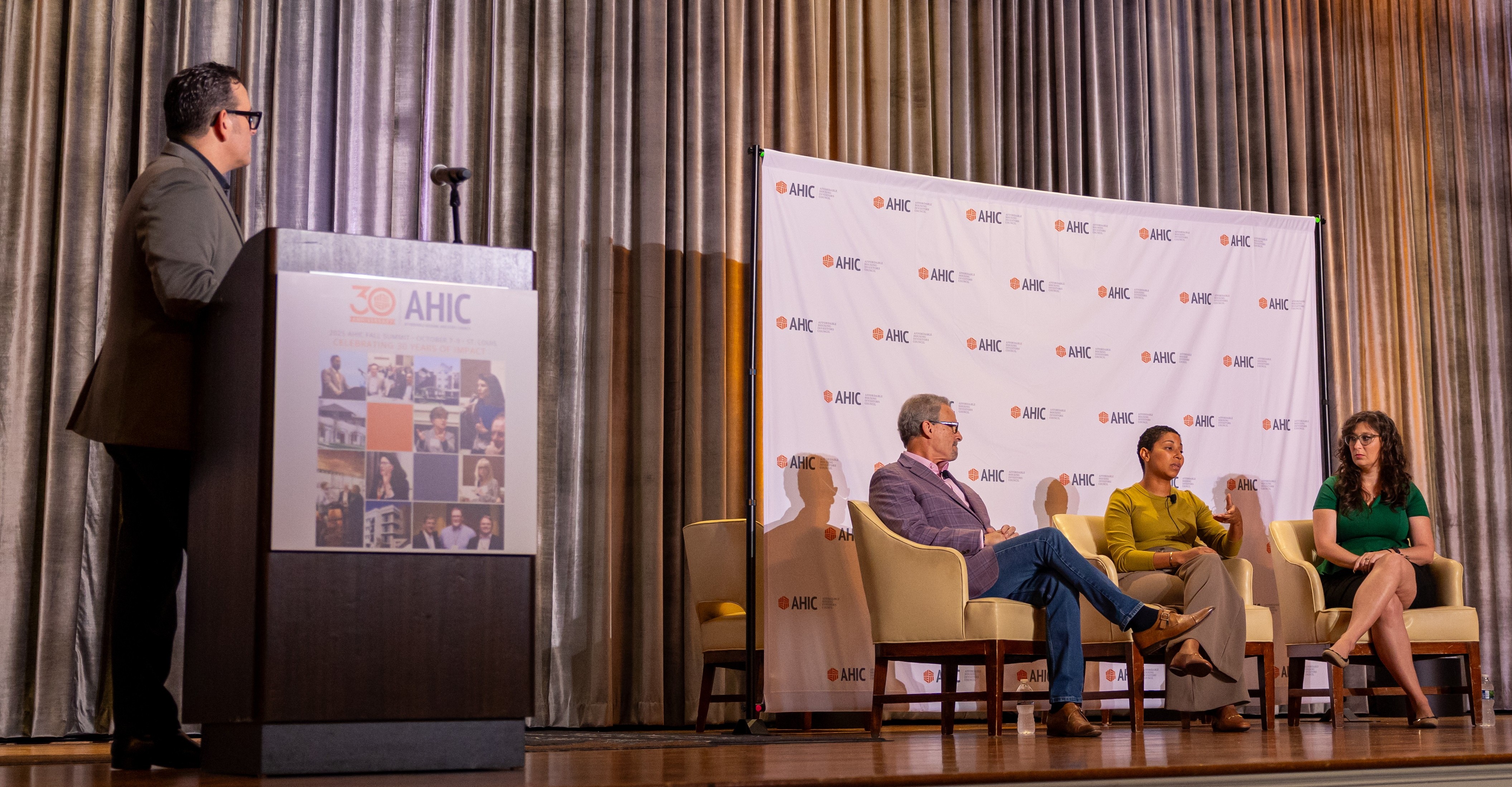St. Louis Confronts Affordable Housing Crisis After Tornado Exposes Systemic Failures
 When a tornado ripped through St. Louis in May 2025, damaging over 10,000 properties and causing $1.6 billion in losses, it didn't create the city's affordable housing problems—it exposed them. At AHIC's fall conference, three local leaders offered a sobering assessment of what the disaster revealed and what it will take to rebuild differently.
When a tornado ripped through St. Louis in May 2025, damaging over 10,000 properties and causing $1.6 billion in losses, it didn't create the city's affordable housing problems—it exposed them. At AHIC's fall conference, three local leaders offered a sobering assessment of what the disaster revealed and what it will take to rebuild differently.The panel—moderated by Zack Boyer of U.S. Bank Impact Finance and featuring Dara Eskridge (CEO of Invest STL), Megan Green (President of the St. Louis Board of Aldermen), and Chris Krehmeyer (President of Beyond Housing)—provided a case study in how decades of disinvestment, systemic inequities, and inadequate tools converge to create crisis.
What the Tornado Exposed
Eskridge's team has worked directly with over 3,000 tornado-affected households. What they found: severe overcrowding with multiple families crammed into inadequate units, absentee landlords creating rapid property turnover, and properties changing hands so frequently that residents don't know who's responsible for repairs when roofs leak and walls buckle.
Many impacted neighborhoods contain homes passed down through generations—owned outright, with housing costs of just $200 monthly for utilities. "How do you go from having just a $200 housing cost to now having to afford a $1,500 rent?" Eskridge asked. Most households were either severely underinsured or carried no insurance at all.
Adding to the crisis: an estimated 4,000 to 5,000 families face losing their homes in tax sale auctions over unpaid bills of less than $2,000. "It would cost a lot more for us as a system to rehouse them than to just address that bill," Eskridge noted.
Krehmeyer emphasized that the tornado simply magnified existing problems. "The vulnerabilities have existed. They always have," he said. "It's been decades of consistent disinvestment, abandonment, longitudinal systemic racism."
Policy Response: Progress and Bottlenecks
Green detailed the city's response, starting with actions already underway before the tornado. Last November, voters passed Prop S, creating a license fee on short-term rentals to fund affordable housing and an Impacted Tenants Fund. After the tornado, the Board of Aldermen expanded the fund to cover natural disaster displacement.
The city has deployed $30 million in interest from the "Rams settlement fund"—$250 million awarded when the NFL team left St. Louis—for tornado relief. But Green acknowledged a painful reality: "The city moves too slowly. Government in general moves too slowly." Funds allocated in July were only beginning to reach the community months later.
On zoning, the city updated a 70-year-old code to allow accessory dwelling units by right and reduced minimum lot sizes from 4,000 to 1,500 square feet. The city is also working to pre-zone closed school buildings for residential conversion.
Yet the resource gap remains enormous. "We are looking at needing at least a billion dollars in funding to really recover from the tornado," Green said.
Moving Beyond LIHTC
The panel didn't mince words about the Low-Income Housing Tax Credit program's limitations. "We have to let go of LIHTC," Green stated. "It is a horribly imperfect tool for financing affordable housing. In many situations it adds 30% or more to the cost of development—that is not sustainable."
Missouri's capped LIHTC program forces projects to apply multiple times, adding carrying costs and creating disincentives. "In the interest of courage, we need to start creating new tools for addressing this," Green urged.
Krehmeyer offered a concrete alternative: Beyond Housing partnered with McBride, Missouri's largest homebuilder, using philanthropic dollars to buy property, clear title, and deliver pad-ready sites. McBride then builds market-rate homes in neighborhoods where they'd never otherwise invest.
On one block where Beyond Housing owns five LIHTC rental properties valued around $120,000 each, McBride built a home that sold for $250,000. That sale created an appraisal benchmark, lifted surrounding property values, and increased the tax base—benefiting desperately underfunded local schools.
"We're not going to create healthy, vibrant communities by just producing rental housing," Krehmeyer said. "It's a piece of the puzzle. Absolutely. And it's a valuable piece. But we have to think differently."
The Scale Challenge
A recurring theme was the need for coordination. Beyond Housing has built hundreds of affordable units and rehabbed 1,500 owner-occupied homes—significant work that's "just not yet at scale to move the needle on community level change," Krehmeyer acknowledged.
The panel described a frustrating dynamic where everyone waits to see who moves first. "The private sector will tell government, 'You need to move, and then we'll move,'" Green explained. "And from the point of government, we're saying, 'We need to know you're going to be with us if we move.'"
Green argued that local government must set the tone—establishing expectations for developers and what benefits must flow to the public in exchange for incentives. Eskridge pointed to models like Chicago, where development fees from downtown support neighborhood investments.
Community Organizing as Foundation
Despite the challenges, panelists identified reasons for optimism. Within hours of the tornado, the "People's Response" organized at the O'Fallon Recreation Center. Over 1,000 volunteers cleared debris and assessed needs. "That community organizing has not left," Eskridge noted. "We've seen it continue to grow and now start to be transferred more into policy."
Looking ahead, the panel debated whether St. Louis could attract climate migrants from regions facing extreme heat and water scarcity. The city has excellent water resources and more tolerable temperatures, but Krehmeyer was skeptical: "Right now, we don't have a whole lot to offer."
Eskridge warned of a darker possibility: "We are going to see a boom... not because of us. It is because people are going to be facing untenable living situations elsewhere." His concern: migration could drive gentrification and displacement of existing residents, especially given absentee ownership of much of the housing stock.
The St. Louis case study offers clear lessons: addressing affordable housing in cities shaped by disinvestment requires new financing tools beyond LIHTC, public-private partnerships that achieve scale, zoning reforms, stronger appraisal systems, and coordination between government, philanthropy, and private capital. Most importantly, it requires defining success around resident outcomes rather than downtown development.
